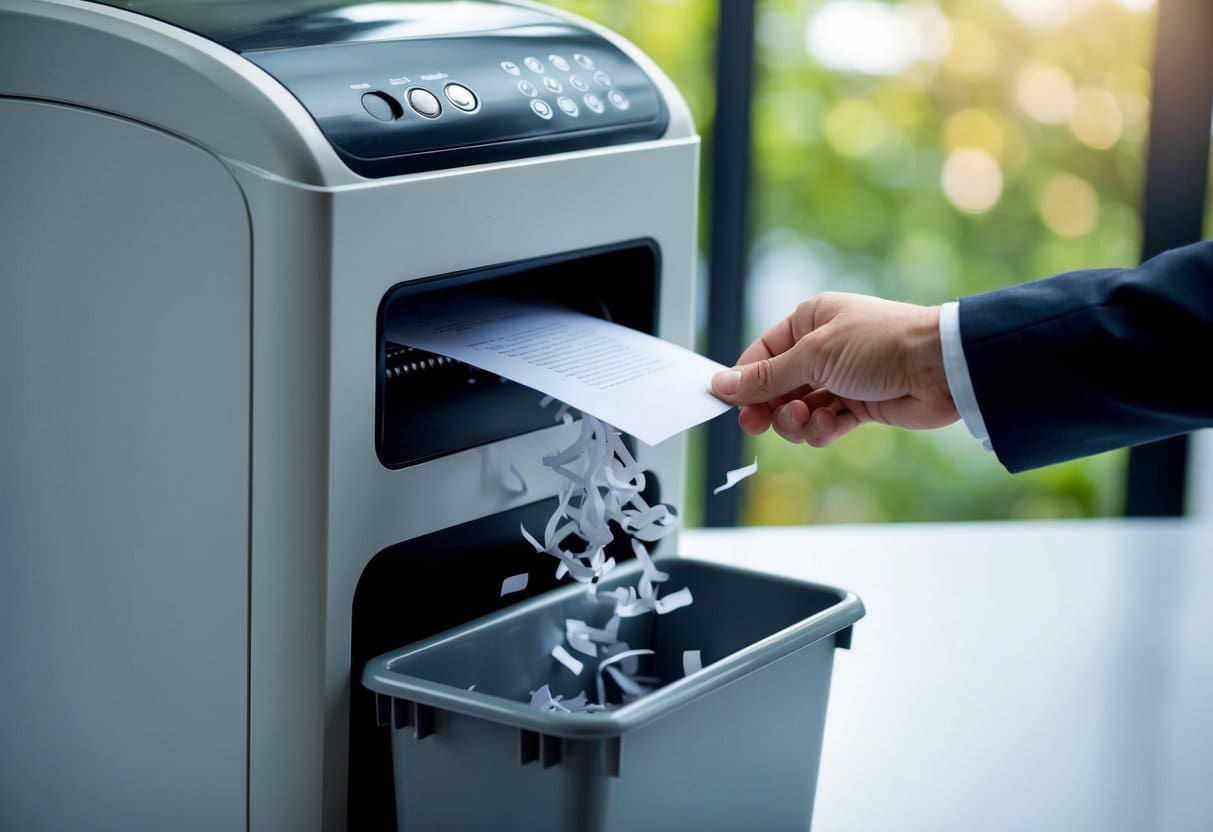Understanding Identity Theft and Document Vulnerabilities
Identity theft occurs when someone steals personal information to commit fraud. Protecting private data is crucial in reducing the risk of such thefts. Sensitive documents can be a major target, making secure shredding essential.
The Mechanics of Identity Theft
Identity theft involves stealing personal or financial information to impersonate someone. Cybercriminals often target various types of data, including Social Security numbers, bank account details, and credit card information. Once obtained, they can open fraudulent accounts, access financial records, or commit other scams.
Our personal and customer data can be compromised through various tactics. These include phishing scams, data breaches, and sometimes physical theft of documents. Understanding these methods helps us recognize vulnerabilities and build better defenses against identity theft.
Sensitive Information at Risk
Sensitive information encompasses a wide range of data. This includes personal details such as names, addresses, and birthdates, and extends to financial information like bank statements and credit reports. These documents are often stored in our homes or workplaces, where they can be susceptible to unauthorized access.
When mishandled, even seemingly minor pieces of information can lead to major privacy violations. Therefore, protecting these documents by shredding them when they’re no longer needed is a critical part of our security strategy. This ensures that unauthorized individuals cannot retrieve this information from discarded papers.
Consequences of Data Breaches
Data breaches can result in significant harm to those affected. When our private information is exposed, it can lead to financial fraud, identity theft, and privacy violations. Victims may find their credit scores damaged or encounter difficulties in obtaining loans. Those responsible for safeguarding data, such as businesses holding customer data, must prioritize security. A lack of protection can lead to legal repercussions and a loss of trust from clients.
By ensuring robust systems and physical document security practices, we can mitigate the consequences of data breaches and help maintain trust.
Secure Document Shredding as a Preventative Measure

Secure shredding plays a vital role in protecting our personal information and ensuring data privacy. By properly disposing of sensitive papers, we can effectively guard against identity theft and ensure compliance with various data protection laws.
Methods of Document Destruction
When we dispose of confidential information, choosing the right method of document destruction is critical.
We often use cross-cut shredders, which slice paper into small pieces, making it difficult for anyone to reconstruct them. Another option is micro-cut shredders, which produce even finer particles for more secure document disposal.
Alternatively, we might consider incineration or pulping. Incineration completely burns documents, while pulping turns them into a mushy slurry. Both methods are effective for large volumes of paper but may require specialized equipment.
On-Site vs. Off-Site Shredding Services
In deciding between on-site and off-site shredding services, we weigh the benefits of each. On-site shredding provides immediate reassurance. We can witness the destruction of documents, which can build trust and ensure data security. A shredding truck can come directly to our location, making it convenient.
Off-site shredding, on the other hand, involves transporting documents to a secure facility for shredding. While this may require more planning, it is often more efficient and cost-effective for shredding large volumes.
Regardless of the choice, using professional shredding services adds a layer of security.
Ensuring Compliance with Data Protection Laws
Compliance with data protection laws is crucial for secure document disposal. We need to follow data protection regulations such as the General Data Protection Regulation (GDPR) or other local laws that apply to us. These regulations guide us on how to properly shred documents to avoid data breaches and penalties.
Keeping up with evolving laws means regularly updating our document disposal practices. We must document every step to ensure compliance. Some data protection laws also require us to have policies for document shredding in place, so periodic audits and staff training are essential. By aligning our shredding practices with these laws, we safeguard both our organization and the privacy of individuals.
Additional Considerations for Document Shredding

Let’s take a closer look at two important aspects of document shredding more deeply. These include how proper shredding can benefit the environment and help us stay vigilant against new types of threats.
Environmental Benefits and Best Practices
- Shredding documents isn’t just about protecting identity and business secrets. It also helps the environment by reducing waste.
- When we shred and recycle paper, there is less need for new paper production. This can save trees, water, and energy.
- Implementing best practices, such as secure on-site shredding, minimizes the risks of documents being recovered by dumpster divers.
- Using energy-efficient shredders and recycling shredded material special facilities help ensure that our environmental impact is reduced.
- Our choices can make a positive difference in both document security and resource preservation.
Evolving Threats and the Need for Vigilance
Threats to our personal and business information are always changing. We need to stay alert to dangers like phishing schemes and corporate espionage. Document shredding must keep evolving to address these challenges. Shredders are more than just machines; they’re part of a broader security plan.
Regularly updating our shredding practices ensures we respond effectively to new threats. This vigilance helps us achieve peace of mind, knowing our sensitive information is protected from those who might wish to misuse it. Staying aware and proactive is crucial to long-term security.





